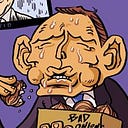Illustrations vs Cartoons vs Comics
What’s the difference, and when do I use each one?
If you’ve ever needed to commission some kind of drawn artefact, you may have wondered what to call it. Are you wanting an “illustration”? A “cartoon”? An “animation”?
This is a basic taxonomy Luke and I came up with for the company we used to work at to help internal clients figure out what they need from us. Generally speaking:
Illustrations can tell you what is happening.
Cartoons can tell you how people are feeling.
Comics can tell you what is happening, how people are feeling and why these are the case.
Illustrations
An illustration is a visual interpretation of an idea, concept or process. It can convey meaning, reduce complexity and add interest to any form of communication.
An illustration can be literal or abstract and can use metaphor and analogy to help tell your story. They might be used in conjunction with text as part of a presentation.
If you have a complex concept and need to explain it simply, use an illustration.
Cartoons
A cartoon is a single drawing which communicates a moment in time, such as touchpoints on a customer journey, where empathy is important.
Cartoons are often the result of our note-taking, or live “graphic scribing”.
A cartoon adds emotional content which is missing from an illustration as described above. There’s now a point of view represented — it could be yours, the artist’s or that of a real or created character.
If you need to explain how people are feeling, use a cartoon.
Comics
Comics (which might be the same as “storyboards”, depending on presentation) differ from cartoons in that they are multi-paneled and can tell a longer story.
They can be used effectively in telling personal stories and are equally useful in explaining a process. They can be most powerful when these stories are combined — showing how a process works, and how it affects people.
They also can encompass more than one tone or message. They can be complex — they tell a story.
When you have a complex story to tell, use a comic.
What about animations?
When people say “cartoon”, they sometimes mean “animation”, and vice versa!
For our purposes, a “cartoon” is a single image (as described above). An “animation” always means “a sequence of images played back at high speed to give the illusion of movement”.
Animations are videos. They usually incorporate sound. This means they have the power to do all a comic does, and potentially be even more immersive.
Because of the exponential amount of work required to create an animation, though, I usually don’t recommend clients in designworld commission their creation.
There’s an assumption that animations are more “grabby” than illustrations, cartoons and comics because they move and yell at you.
This can be true, depending on context, but, on checking the stats of our company’s intranet, Luke and I confirmed that people had much less engagement with video content (unless the video explained how to get extra employee benefits or was a message directly from the CEO!).
Comics, cartoons and illustrations can be an excellent way to deliver a message. They help people look at things (including themselves) differently.
It’s important to understand what type of imagery is most appropriate for the subject you’re communicating, though.
David Blumenstein is a service designer and cartoonist. Luke Watson is a creative director and cartoonist. They are running the workshop they created, Drawing for Story, this Saturday in Melbourne, and David is running it with Ben Hutchings on August 16 in Canberra. Three hours of visualising a communication challenge you’ve brought with you. Bookings are open.
